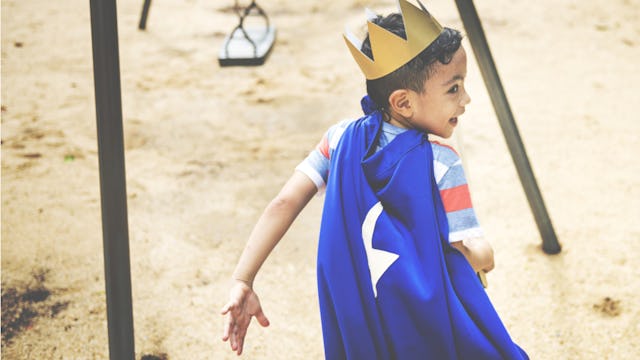The One Toy That Never Collects Dust? The Dress Up Box! Get One.

It’s not unusual, at any time of year, for a pack of little costumed people to be running around my house. They might be police officers with plastic badges, or chefs in aprons, or something else entirely in cowboy hats and masquerade-ball masks. But whatever they are, each outfit has something in common: They are the catalysts for play, the stuff imagination is built upon, and they are having a blast.
Watching what my kids (and their friends) turn into when they put them on is the best part — because when they’re given free rein to be creative, they become completely engrossed in whatever world they’re dressed for. They may be totally naked except for a cape, but pants are optional when you’re creating a new brand of superhero.
Like most kids, mine have been the recipients of an endless parade of toys. But of all the games, dolls, and baubles that have ever been stuffed into their closets, or donated after collecting months of dust, they’ve never played with anything more than that Rubbermaid tote full of random clothing and accessories.
When the sparkle of the latest must-have plaything fades, the allure of the dress-up box remains constant, probably because it’s always changing as we add new things. The combinations are endless. And unlike most of the other crap they’ve had, the stuff in their dress-up box was cheap. Every year, we add to it with whatever Halloween costumes they wore, so they can get much more than one night’s use out of them. (Bonus: When the holiday is over, clearance sales allow you to snag costumes and props for next to nothing.)
The kids got plastic fire hats from a safety demonstration and strings of shiny green beads from the St. Patrick’s Day parade; into the box they went. Dollar stores and craft stores have headbands with googly eyes and glasses with moustaches and feather boas for less than the price of a Happy Meal. An unused scarf from the back of my closet has been transformed into a shawl, a belt, a head covering, and an old pair of sunglasses has been used to outfit every kind of character from a movie star to a spy to a “cool dude.”
Thrift stores and rummage sales are a treasure trove of finds for unbelievable prices: I once scored a kid-sized tuxedo suit, a basketball jersey, and an embroidered silk kimono for 8 bucks. When it comes to dress-up items, there are no brand names, nothing that’s less desirable — each piece just adds to the possibilities. The quirkier, the more unique, the better.
I can’t think of a better investment. Monetarily speaking, it’s hardly an investment at all, but it’s one of the best gifts I could have ever given my kids: the encouragement of their imaginations to run wild, to be whoever they want to be, to try on as many different personas as they can. They learn empathy as they see their world through the eyes of the characters they choose to play. They invent and manipulate storylines, bolstering creativity. They build social skills by involving their playmates in their make-believe scenarios and emotional skills by reacting to the exciting events that happen in their fantasy worlds. On the practical side, it gives them experience with buttons and zippers and hooks and laces, building up those fine motor skills, and I am so down for anything that will teach them to fasten all those things by themselves.
My son once galloped into the room wearing a cape, a cowboy hat, and a pair of boots — nothing else — and proclaimed that he was going to eat all of his lunch so he could be “as strong as a buffle hag.” I’m not sure exactly how strong a buffle hag is (or what it is, for that matter). But thanks in large part to our dress-up box, I don’t have any doubts about the strength of his imagination.
I will sing the praises of the dress-up box forever. If you feel like your kids are overwhelmed by playroom clutter, get rid of some of those toys and start costume shopping asap.
This article was originally published on